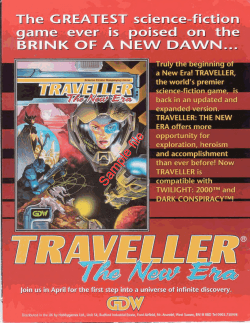
History Day & Grade Level Content Expectations Grade 8
History Day & Grade Level Content Expectations Sample Topics for “Leadership and Legacy” Grade 8 SOCIAL STUDIES- HISTORY AND GEOGRAPHY USHG ERA 3 – REVOLUTION AND THE NEW NATION (1754-1800s) 3.3 Creating New Government(s) and a New Constitution USHG ERA 4 – EXPANSION AND REFORM (1792-1861) 4.1 Challenges to an Emerging Nation 4.2 Regional and Economic Growth 4.3 Reform Movements USHG ERA 5 – CIVIL WAR AND RECONSTRUCTION (1850-1877) 5.1 The Coming of Civil War 5.2 Civil War 5.3 Reconstruction USHG ERA 6 – THE DEVELOPMENT OF AN INDUSTRIAL, URBAN, AND GLOBAL UNITED STATES (1870 – 1898 in Grade 8) 6.1 America in the last half of the 19th Century SOCIAL STUDIES- INTEGRATED U.S. HISTORY 8 – U6.2.1 United States History Investigation Topic and Issue Analysis, Past and Present –Use historical perspectives to analyze issues in the United States from the past and the present; conduct research on a historical issue or topic, identify a connection to a contemporary issue, and present findings (e.g., oral, visual, video, or electronic presentation, persuasive essay, or research paper); include causes and consequences of the historical action and predict possible consequences of the contemporary action. (National Geography Standards 9 and 10, pp. 160 and 162) SAMPLE TOPICS — “Leadership and Legacy” George Washington: Leading the US to Independence Tecumseh and the Western Confederacy: Leading the Battle Against Westward Expansion Drawing Boundaries: Thomas Jefferson’s Land Ordinances and the Settling of the American West The Case of Anthony Burns: His Legacy Under the Fugitive Slave Act The Legacy of Reconstruction and Andrew Johnson ENGLISH LANGUAGE ARTS- WRITING, SPEAKING W.8.2. Write informative/explanatory texts to examine a topic and convey ideas, concepts, and information through the selection, organization, and analysis of relevant content. a. Introduce a topic clearly, previewing what is to follow; organize ideas, concepts, and information into broader categories; include formatting (e.g., headings), graphics (e.g., charts, tables), and multimedia when useful to aiding comprehension. b. Develop the topic with relevant, well-chosen facts, definitions, concrete details, quotations, or other information and examples. c. Use appropriate and varied transitions to create cohesion and clarify the relationships among ideas and concepts. d. Use precise language and domain-specific vocabulary to inform about or explain the topic. e. Establish and maintain a formal style. f. Provide a concluding statement or section that follows from and supports the information or explanation presented. W.8.4. Produce clear and coherent writing in which the development, organization, and style are appropriate to task, purpose, and audience. W.8.5. With some guidance and support from peers and adults, develop and strengthen writing as needed by planning, revising, editing, rewriting, or trying a new approach, focusing on how well purpose and audience have been addressed. W.8.7. Conduct short research projects to answer a question (including a selfgenerated question), drawing on several sources and generating additional related, focused questions that allow for multiple avenues of exploration. W.8.8. Gather relevant information from multiple print and digital sources, using search terms effectively; assess the credibility and accuracy of each source; and quote or paraphrase the data and conclusions of others while avoiding plagiarism and following a standard format for citation. SL.8.1. Engage effectively in a range of collaborative discussions (one-on-one, in groups, and teacher-led) with diverse partners on grade 8 topics, texts, and issues, building on others’ ideas and expressing their own clearly. a. Come to discussions prepared, having read or researched material under study; explicitly draw on that preparation by referring to evidence on the topic, text, or issue to probe and reflect on ideas under discussion. SL.8.4. Present claims and findings, emphasizing salient points in a focused, coherent manner with relevant evidence, sound valid reasoning, and well-chosen details; use appropriate eye contact, adequate volume, and clear pronunciation. SL.8.5. Integrate multimedia and visual displays into presentations to clarify information, strengthen claims and evidence, and add interest.
© Copyright 2025





















